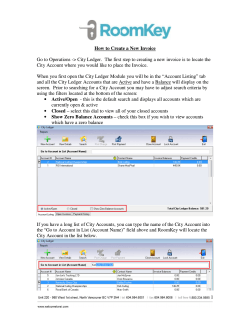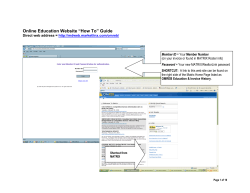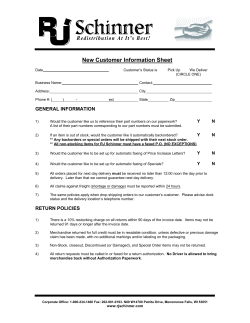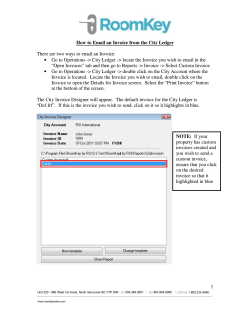
Processing
Processing ❖ Accounts Payable Recurring P ayables: Account Sour ce Hierar chy Payables: Source Hierarchy ❖ Company ❖ Organization ❖ Account Number (Multiple Distribution) ❖ Company ❖ Organization ❖ Account Number ❖ Organization (overrides Vendor Type Master) ❖ Account Number (overrides Vendor Type Master) ® ACP.21 © 1999 Unbeaten Path International Ltd. Processing ❖ Accounts Payable Special Rules for Commodity Codes Service Commodity Processing BPCS system logic handles the service and material commodity types differently during purchase order processing and invoice entry in accounts payable. Rules for service commodity processing are addressed below: Pur chase Or der Cr eation urchase Order Creation ∇ To signify that a purchase order is for commodity items, enter a “1” for inventory type on the second screen of PUR500. ∇ Enter a commodity code for a P.O. line. BPCS will then retrieve default accounting information (profit center and account number for the expense / asset account) from the Commodity Master file and will assign that accounting information to this P.O. line. ◊ Both the default profit center and the default account numbers may be manually overridden by the user. ◊ The order quantity for a given P.O. line will always default to “1” even if the user enters a quantity much larger than one. ∇ A purchase order receipt for the service commodity is automatically created by the BPCS system. Therefore, the user will never have to perform the PUR550 Purchase Order Receipt function to signify that the service commodity has been performed. Accounts P ayable Invoice Entry and P ayment Payable Payment ∇ Execute ACP500, entering the purchase order number on the first screen. ◊ Skip the second screen of ACP500 because no costing information is required. ® ACP.33 © 1999 Unbeaten Path International Ltd. Accounts Receivable ❖ Setup A/R Maintenance Cycle: P unction Prrogram Sequence & F Function A/R Cycle Sequence Number Program Name Program Number 1 System Parameters SYS800 Defines system-wide defaults and tailoring parameters 2 Tax System Parameters SYS810 Defines system-wide defaults and tailoring parameters 3 Company Master ACR120 Defines the company to be used 4 Organization Master ACR130 Defines all organizations 5 Customer Types ACR170 Sets up customer types to group customers based on currency code and general ledger account 6 Customer Terms ACR110 Sets up terms codes which define specific payment terms for customer invoices 7 Payment Types ACP170 Define types of payments to be received from customers 8 Bank Branch Master CSH130 Defines the branch of the bank that will be used by the system for posting customer cash 9 Bank Master ACP140 Defines the bank that will be used by the system for posting customer cash 10 Tax Rate Code SYS140 Defines various tax rates that may be applied to customer invoices 11 Tax Rate Tables SYS150 Links customer tax code with an item tax code 12 Dunning Letter Set ACR150 Defines dunning letter sets which indicate the dunning letter(s) that will be generated for a customer 13 Document Sequencing ACR160 Defines codes by which customer invoices can be grouped and sequential numbers assigned 14 Salesperson Master SAL100 Defines salesperson information 15 Customer Master ACR100 Defines all required customers 16 Ship-to Master ORD100 Defines customer ship-to locations 17 Reason Codes SYS170 Defines codes that specify reasons for a particular transaction 18 Default Reason Codes SYS180 Defines reason codes that will default during various transaction programs Program Function ® © 1999 Unbeaten Path International Ltd. ACR.8 Accounts Receivable ❖ Processing Customer Account Maintenance Account Source Hierarchy For Invoice Entry (Cash and Memo Posting Mode 1), and Debit Memo Entries (Cash and Memo Posting Mode 2) when the Debit Memo is not applied to an existing invoice. ❖ Company (data entry field) ❖ Company (data entry field) ❖ Organization (override capable) ❖ Organization (override capable) ❖ Accounts Receivable Account Number ❖ Revenue Account Number ❖ A/R Account Number If the Debit Memo is applied to a pre-existing invoice, then the accounting hierarchy is derived from that pre-existing invoice, unless overridden. (overrides Company Master) ® © 1999 Unbeaten Path International Ltd. ACR.44 General Ledger ❖ Setup G/L Journal Summarization F eatur es Featur eatures ® © 1999 Unbeaten Path International Ltd. GLD.18 General Ledger ❖ Processing Period-end Close P Prrograms Sequence Number Program Number Program Name Comments Mo. End Close Yr. End Close A/P & A/R Related 10 A/R Period Close ACR900 11 Month-end File Purge ACP900 12 1099 Report ACP920 13 Month-end Close PUR900 Purges invoices with a zero balance; date cashed < or = "# of days to retain data" Y Purges completed reqs and P.O.s; rolls MTD to YTD totals in AVH. Y Cost & Inventory Related 14 Shop Costing Post / Close CST900 15 Capacity Week-end Close CAP900 16 Cycle Count Purge INV015 17 Month-end Close INV900 Computes new beginning inventory balance. Clears entries, adjustments, additions and subtractions fields. 18 Post Inventory to G/L INV920 Gets records from ITH file, and can be run at any time. INV920 posts inventory transactions from the Transaction History file (ITH) to the Batch Interface file (GJW). Rolls planned hour buckets for input / output. It refreshes the WMHRS file. Y After running INV920 there should be no INV920 spool file. If there is an INV920 spool file, there were errors during the post. Fix errors and run INV920 until there is no INV920 spool file. ® © 1999 Unbeaten Path International Ltd. GLD.34
© Copyright 2025





















